Photo courtesy of Kamil Krzaczynski-USA TODAY Sports
Date: May 16
Opponent: Pittsburgh Pirates
Location: Wrigley Field
Introduction
For frontline starting pitchers, some starts are memorable for taking place in either the first week of April (Lester’s Opening Night start vs. St. Louis) or the last week of October; some are memorable for their sheer dominance (Lester’s start against Milwaukee); and some are memorable because they come at a crucial point in their team’s season (Lester’s start in St. Louis when Cubs had lost five out of six games).
The majority of games started throughout a season, though, do not fit into any special category. They do not come against a division leader or feature a lights out performance from the ace. When the story, or ballad, if you will, of Jon Lester’s 2015 season is written, start number eight will likely be a footnote, if included at all. However, it was yet another strong start for Lester, as he gave the Cubs seven innings a day after they needed seven relievers to go 6 1/3.
Sure, it was not Lester’s crispest start of the season. He gave up at least one hit in every inning after the first. For the second consecutive start, he gave up at least one home run on his four-seam fastball. And after needing just 36 pitches to get through the first three innings, he needed 74 pitches to get through his final four innings.
However, there was still plenty to like. Lester increased his curveball frequency for the fourth consecutive start (see Pitch Breakdown section), and it has become an incredibly effective pitch. He continued to get ahead of opposing batters, and against the Pirates got ahead of a season high 78 percent (23 of 30). Lester also produced a season high number of whiffs (16) and whiff percentage (14.6 percent).
Of course, as has been the case of late against the Mets and Brewers, Lester is matching up against teams with poor offenses. In 2015, the Pirates have not quite been the excellent offensive team many predicted in the offseason. As a team, they rank bottom five in the National League in OBP (.300), SLG (.366), OPS (.666), walk rate (6.4 percent), strikeout rate (20.9 percent), and ISO (.126). There have been few baserunners and little power. And it has been even more dismal against left-handed pitchers, as they are hitting just .211/.271/.349. While the overall season has been a struggle, the Pirates had scored 48 runs in nine games leading up to the showdown with Lester.
Lester got the home stand off to a strong start against the Mets. On Saturday, he played a vital role in keeping the fun times going. Continue reading below to see how it all went down.
Traditional Line
7.0 IP, 9 H, 7 K, 1 BB, 1 ER
Pitch Breakdown
110 pitches (74 strikes)
| Total | Velocity (Max) | AVG | SLG | BABIP | |
| Four-Seam | 39 | 93.1 (95.0) | .556 | .889 | .800 |
| Cutter | 31 | 88.9 (91.2) | .167 | .167 | .200 |
| Sinker | 14 | 92.5 (94.2) | .400 | .400 | .400 |
| Change-Up | 1 | 84.3 (84.3) | .000 | .000 | .000 |
| Curveball | 25 | 76.0 (78.9) | .125 | .250 | .200 |
Of the 23 batters Lester got ahead of in the count, 19 came via the four-seam, two-seam, and cut fastballs. For the fourth consecutive start, batters were less aggressive on Lester’s fastballs in the strike zone, allowing him to get ahead in the count:
Compare that to his first four starts, when batters were attacking pitches over the plate and laying off the pitches outside the strike zone:
His cutter was perhaps the most effective it has been all season. In his last two starts, batters are just 3-for-16 with three singles against the cut fastball. Through the first six starts, batters hit .400/.426/.644. Lester is using the pitch to hit corners and induce whiffs (see Keep in Mind section), as he threw five for first-pitch strikes on Saturday.
Against the Pirates, Lester threw his most curveballs of the season, both in total pitches (25) and percentage of pitches (22.7 percent), and surrendered just one hit. As we went in too much great detail after his last start, Lester is doing a remarkable job of using his fastballs early in the count to set-up the curveball.
This happy marriage of pitches was on continued display from the game’s second batter, Neil Walker, who went down swinging on a curveball that ended up at his ankles. This was made possible, because Lester was able to locate a 94 mph four-seamer on the outside corner for a first-pitch called strike. He then spotted a cutter on the inside corner for a called strike two. After attempting to go back off the plate and get Walker to chase a 93 mph four-seamer, Lester unleashed a vicious curve for strike three:
After Monday’s start against the New York Mets, we discussed that:
When Lester is struggling, he abandons his curveball and relies almost exclusively on his fastballs. Even if his four-seamer, cutter, and sinker are not effective, Lester has a tendency to abandon his breaking and off-speed pitches and rely on speed. When he is going well, locating his fastballs to get ahead of batters, he will go to the curve.
Well, in his last three starts, Lester has thrown the curve 19.6 percent of all pitches, after throwing it 12.9 percent of all pitches in his first five starts. For the season, he has now thrown it 15.6 percent of the time. As we detailed last week, in each of the four seasons that Lester has kept his curveball usage above 15 percent he has, at the very least, been worth 3.1 wins, according to WARP.
Trends
In his last two starts, Lester has run into a slight blip with his four-seam fastball, which had been his best pitch through his first six starts. He has now surrendered three home runs off the pitch, with two of the three coming against right-handed batters.
| Four-Seam% | K% | HR | AVG | SLG | BABIP | |
| Starts 1-6 | 43.6% | 29.3% | 0 | .185 | .259 | .220 |
| Starts 7-8 | 36.4% | 15.0% | 3 | .500 | 1.063 | .500 |
On the first pitch of the third inning, Ross set-up down and away:
Lester, however, missed significantly up and out over the plate with a 91.6 mph four-seamer:
Few, if any, major-league hitters will miss a heat at that velocity in that location, even one with a career .674 OPS. While Lester has been using the pitch to get ahead in counts and put hitters away (see Key At-Bat section), he has begun to leave it up in the zone, which is the issue he had with cut fastballs through the much of the season. It has been just two games, so it is too early to panic, but it remains worth monitoring.
Key At-Bat/Sequence
Inning: Fourth
Score: 2-1, Cubs
Situation: Starling Marte on third base, Jung-Ho Kang on second base
Batter(s): Corey Hart
Lester had faced just one batter over the minimum through the first three innings. In the fourth inning, though, the wheels came off, if just for a moment.
With one out, Marte reached via an infield single and stole second base. Kang followed by blooping a base hit to right field on a fastball on which he had been beaten by Lester. In 2015, Lester has been the victim of some tough-luck base hits that led to big innings, and the fourth inning had all the makings of exactly that.
With Corey Hart coming to the plate and runners on second and third and just one out, Joe Maddon elected to keep the infield back and concede the tying run. It was an interesting decision, considering Hart entered the game with a 55 percent groundball rate on the season. And while Hart has struggled mightily in 2015 (.206/.222/.324), he has been very good against left-handed pitchers (.286/.358/.498) throughout his career.
Lester came inside with the first four pitches: Three fastballs and a curve:
On the 1-2 pitch, Ross set up off the plate:
Lester hit that spot with a 93.6 mph four-seamer:
Hart swung through the pitch flat footed. After coming inside on four straight pitches, Hart seemed unprepared for the four-seamer off the outside corner. Entering the game, Hart was hitting just .222/.222/.222 against four-seam fastballs in 2015. Ross called the ideal pitch and Lester hit the spot. Lester would then strikeout Rodriguez to end the threat. As we detailed above, Lester has been leaving four-seam fastballs up in the zone, but against Hart he utilized the pitch to neutralize the threat.
Keep in Mind
Yes, Lester surrendered nine hits, but three were infield singles. As you can see below, Lester is continuing to work from the corners out:
- Whiffs on pitches outside of the strike zone – 8 (tied season high)
- Called strikes on pitches on the edge of the strike zone – 15
- Outs recorded from pitches outside of the strike zone – 3
Lester’s continued ability to locate his pitches kept the Pirates from putting together sustained rallies.
Conclusion
While the Pirates did have nine hits, they did not consistently make solid contact. It was not Lester’s best starts of 2015, but he continues to pitch deep into games by getting ahead of batters, locating his pitches, and minimizing the damage when there is traffic on the basepaths. Lester’s April and the 6.23 ERA and 1.57 WHIP seems like a distant memory. The Cubs have now won six of his eight starts. He’s rolling and so is the team. This is getting pretty fun, huh?
Season-to-Date
4-2, 3.70 ERA, 1.356 WHIP, 22.4 K%, 6.2 BB%
Next Start
Friday, May 22 at Arizona (Josh Collmenter)

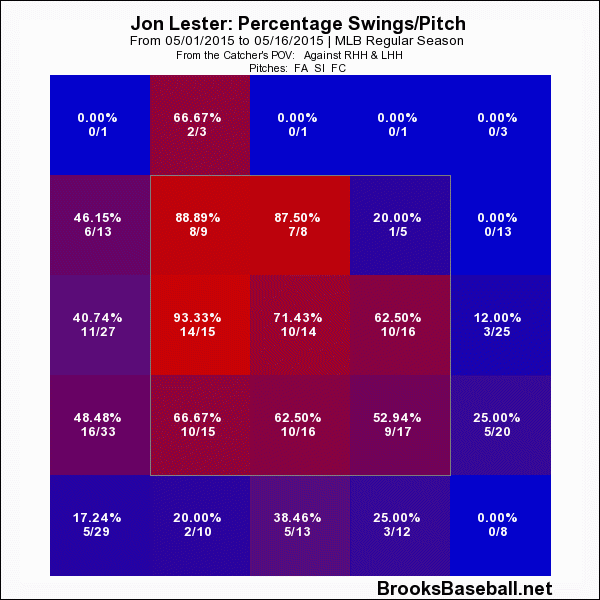
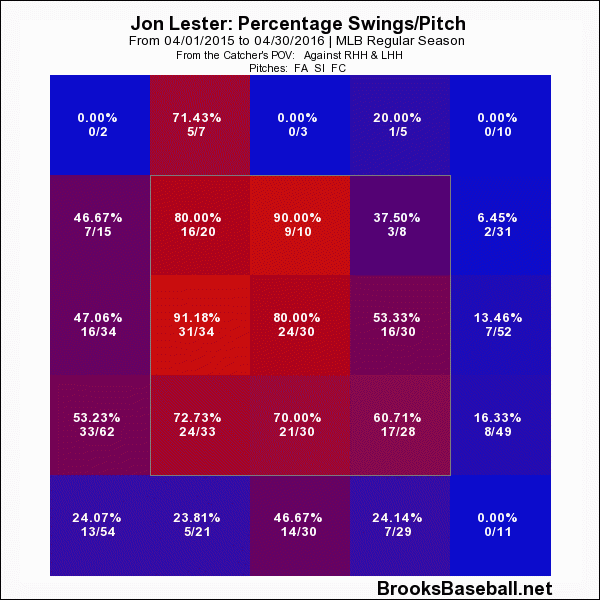

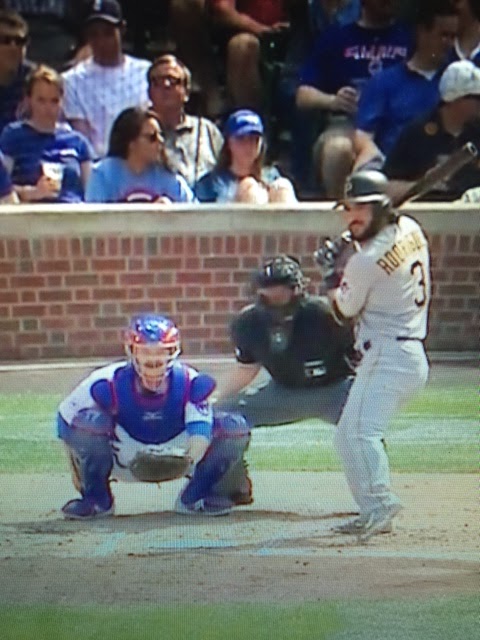
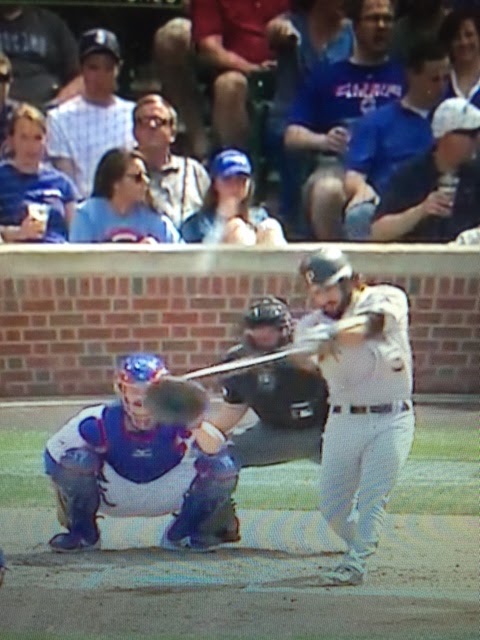
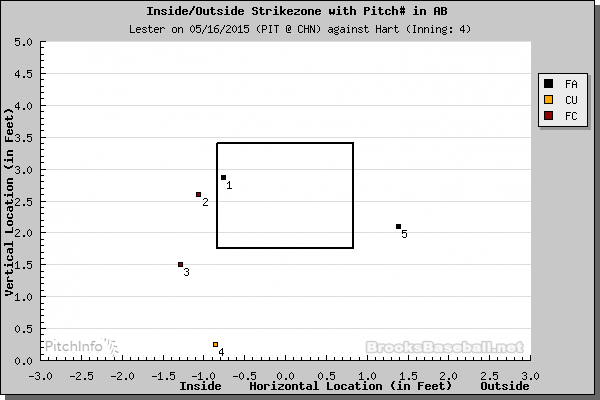
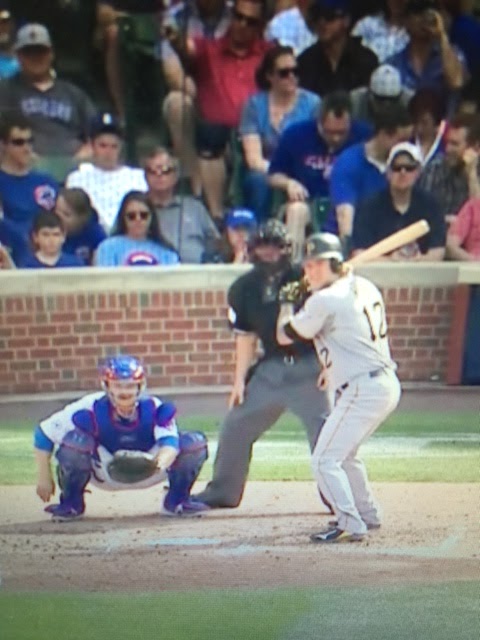
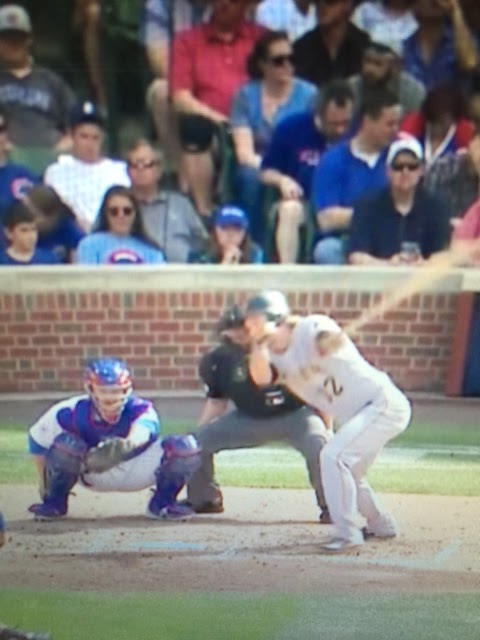
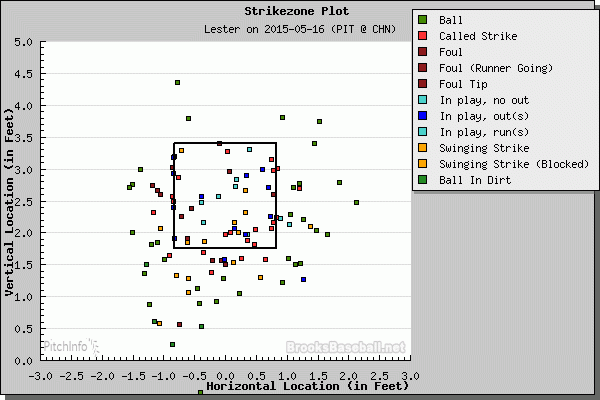
I am the intended audience for wrigleyville, so if i didn’t like it you all would be in trouble. that said, you guys are doing really great stuff. I can’t believe I wasted my youth reading the tribune.
James, Thanks for reading! I wasted my youth watching Around the Horn, so we all make mistakes.
That’s an insanely detailed write up on a not so important performance. And I mean that in the most complimentary way possible. I wonder how an actual MLB scouting report from that game would differ in content.
Bravo.
Thanks for the kind words, Jamie! A MLB scouting report would likely not feature my trademark stale sarcasm, self-loathing, or rambling self-indulgent introductions.